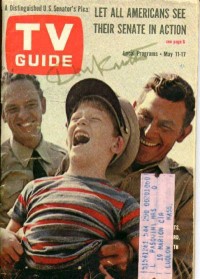Andy Griffith Appreciated, Lots Of Other Stuff Touched Upon

“In Mayberry, Thelma Lou didn’t put a cigarette out on Barney’s arm like my girlfriend did to on mine; Andy Taylor wasn’t embittered or slump-shouldered after a lifetime of ridicule by those with more social status; no Beasley beat his wife half to death with a shoe. Still, Mayberry was a believable universe without these things. Tools of television helped make this true — camera angles, lighting, a disciplined laugh track, extras so far in the background they are almost invisible, along with other aspects I’ve mentioned. But there is one thing about the story that has not been discussed, and it is the thing that gives it gravitas, and why I, and others, watched. Opie’s mother is dead, unaccountably, before the show begins — it’s what sets the fiction in motion. Aunt Bee arrives to keep Opie from growing up wild and sullen — to keep the home from falling apart. The show offers humor as a way to contend with a constant state of grief.”
— Awl pal Evan Smith Rakoff writes about Andy Griffith and North Carolina and Edward R. Murrow and Thomas Wolfe and Danny Thomas and Robert Burns and the Emmys and the Oscars and folk music and television and a Neutral-Milk-Hotelly band called Radiator Hospital and small-town American life and tourism and classism and I can almost guarantee that if you read it you will learn some interesting things that you didn’t know before you did.
Are You Itchy?
“What is an itch? Scientists have speculated that it is a mild manifestation of pain or perhaps a malfunction of overly sensitive nerve endings stuck in a feedback loop. They have even wondered whether itching is mostly psychological (just think about bed bugs for a minute). Now a study rules out these possibilities by succeeding where past attempts have failed: a group of neuroscientists have finally isolated a unique type of nerve cell that makes us itch and only itch.”
South Brooklyn Has Lost Its Real Estate Mind

Over the last three years, everyone bought everything in South Brooklyn. Now, the dregs are being dumped onto the market, for surprising — some would say shocking! — prices. Obviously the big palatial townhouses of Cobble Hill, Boerum Hill and Carroll Gardens still get listed at $2 and $3+ million. (Also, haha, here is an awful one-bedroom for $760K.) 71 3rd Street, which is two tiny, tiny stories and a basement, recently sold for $1.2 million. 339 Hoyt Street, which was harrowing, if largely untouched — the stairs were made of plywood, held together by little brackets — sold for $1.47 million a few months ago. And now it gets worse.
Exhibit A: a shabby 20×40 foot building, untouched since… the late 70s? Can be yours with a mortgage of $6200 a month. How untouched?

Yes.
Exhibit B: 81 2nd Street, 1800 square foot for $1.4 million. Everything inside it needs to be burned so that it doesn’t return in some horrible zombie manifestation and kill you.

Exhibit C: A gorgeous, if smallish, renovated little townhouse on Bond Street. 2000 square feet. $1.8 million. Hmm, Bond Street, Bond Street… OH RIGHT THERE WAS JUST A HURRICANE THAT TURNED BOND STREET INTO A WAIST-HIGH RIVER OF TOXIC SLUDGE.
Rich People's Birds Live Better Than You
“A Swedish homeware company has produced a luxury bird house, complete with swimming pool and garden furniture.”
This Is A Good Place To Be Rich In
“New Yorkers assume that we live in the most expensive city in the country, and cost-of-living indexes tend to back up that assertion. But those measures are built around the typical American’s shopping habits, which don’t really apply to the typical New Yorker — especially not college-educated New Yorkers with annual household incomes in the top income quintile, or around $100,000. According to a recent study by Jessie Handbury, an economist at the University of Pennsylvania’s Wharton School, people in different income classes do indeed have markedly different purchasing habits. That may not be surprising, but once you account for these different preferences, it turns out that living in New York is actually a relative bargain for the wealthy.”
"Hey Foxy!" Inside The Oil Boom's Amazing Bachelor Boom
by Maya Rao

I was barely a moment inside Walmart, studying the cucumbers and avocados, when a middle-aged man came up to say hi.
We started talking about the oil boom sweeping Williston, North Dakota. He said his coworkers were losing it out here in the middle of nowhere. Maybe he would lose it too.
“You gotta really be focused on your shit,” he said. “And it’s hard. And on that note, that’s why you should let me take you to dinner.”
I declined. He called later that evening to ask me on a date. He said he’d take me to Pizza Hut. I was not pining for a rendezvous with a roustabout that I did not know, so I invented other plans. He phoned twice more.
Other women in Williston warned me this would happen. They said they couldn’t go anywhere alone without receiving an offer of some kind from an oil worker. They said the 24-hour retailer on Route 2 was the worst. The parking lot was crammed with cars bearing license plates from dozens of states, any time of day, as guys poured in from all over the country to make their fortune.
Working in Minneapolis, I’d come across stories about the wild impact of the discovery of billions of barrels of oil in western North Dakota. The high-paying jobs. Once quiet farm roads now straining with traffic. Crime. Rents on par with Manhattan.
And another remarkable effect that only came into focus when I visited Williston myself: an influx of men — single men, married men, overworked men, lonely men, men with big dreams, men who keep their heads down and men who cause trouble — has made it an overwhelming place to be female.
The ratio of men to women is nearly a legend. Some say it’s two or three to one. One drunk man on the dance floor at DK’s Lounge and Casino swore up and down to me that it was 153 to one. Married or single, ugly or beautiful, old or young, a woman here is in high demand.
I drove 10 hours west from Minneapolis after a friend of friend, Ben Harp, helped set me up with a place to stay and offered to show me around. He told me to meet him in the Walmart parking lot.
“You should see what I’m hitting on,” was the first thing he said to me.
In a country accent, the young oil worker from Idaho relayed how the night before, he was out at a bar called Champs, drunkenly flirting with a 53-year-old woman — hey, there weren’t a lot of options that night — when she punched him in the face.
There was too much competition anyway.
“You have to be alpha to the max around here,” Harp said.
He didn’t even go out much anymore because too many guys at the bars were eager to get into fights. It wasn’t worth it.
We picked up a friend and then headed to Applebee’s for dinner. “That’s the hotspot,” said Harp. “It’s got the cutest chicks in town. The food’s terrible, and the service sucks, but… there’s no other place to go.”
Later in the night we headed to the only two strip clubs in town. They sit right next to each other on Main Street, near the train tracks, and infamously fly in women in from all over the country to work a week or so before rotating them out for new ones.
At Heartbreakers, we ran into Crystal, a twenty-something girl that Harp knew. Five guys were pursuing her, she said. She rolled her eyes. Some offered to take her on shopping sprees to the outlet malls, two hours away in Minot. But why bother?
“It’s a fat girl’s paradise,” said Crystal, who was thin.
In Williston, the women sometimes sounded like stereotypical men — casual about committing, feeling no pressure to lock a guy down — while the men sat around like aging, anxious single women fretting that the opposite sex had too many choices.
“There’s women out there that their personality may be fine, but their looks are not, and yet they still got three guys looking for them,” complained one oil worker named Glenn. “There’s some of them that play games — this guy is my boyfriend this week, and that guy is my boyfriend next week.”
At Whispers, the other strip club, Williston native Colt Treffry shared a story that sounded lifted from a country song: a man who came from Colorado to work the oil fields stole his wife away.
His wife had been at a bachelorette party at DK’s. Then this guy came up to her, and, “he said, ‘You’re the most beautiful thing I ever saw,’” Treffry said. “I guess that’s what got her.”
“Guys are hitting on girls 24/7,” Treffry said. He has a new girlfriend now. “I could be sitting right next to her in the bar and a guy will come up and say, ‘Hey, you wanna come with us?’… There’s too many guys compared to women out here.”
The average annual wage in the county is $77,000. (The average wage in the state is pretty close to half that.) No college degree needed.
“That’s how most guys start off,” said Rob Strouf, a friend of Treffry’s: “’I work for Halliburton, how you doing?’”
In 2000, the census put the town’s population at about 12,000. Some estimates put it at 30,000 today, and the police force has more work to do. Overall, calls for police service have tripled. Police calls for fights have risen two and a half times since 2009. Domestic dispute calls have increased one and a half times. Sexual assault cases have fallen slightly, although plenty of women don’t feel safe.
At least three guys a day have tried to get Heather Montgomery, an employee at a staffing agency for oil companies, to go on a date with them. She had to order one man out of her office.
“He was young, he wasn’t bad looking,” Montgomery said. “It’s just, my God, the way he came on to me! He said he was going to stalk me on Facebook until my status changed to single.”
One man got the wrong idea when Keri Boda helped him find a frying pan. She was working as a saleswoman at the time. He asked her out for coffee.
“I said, ‘No thank you, I’m married,’ and he goes, ‘Well, don’t let that stop you,’ and I said, ‘I think I will,” said Boda. She now works at the library. “It made me nervous. He would come back a lot and ask for me and I would go hide.”
One guy from Alaska, stopping in Williston from Minot, boasted to me at Whispers that he had bedded three girls since moving to North Dakota nine months earlier.
“Hey foxy!” he texted me later. “Matt here, come visit me.” Minot and its outlet malls were not sufficiently tempting.
Another man I interviewed later called and called. When I finally picked up, he said it was just nice to meet me, and he asked how I was doing.
“HELLO HOW YOU DOING TODAY,” he texted me later.
At third guy messaged me after I left town to say he would come visit. I told him he was too old. “Lol I’m 50 but fun lol,” he texted.
Such attention wasn’t frightening for me, the way some women I spoke with felt. It wasn’t flattering, either. It was about being a woman in a place where women could be in demand as much as the oil.
Maya Rao is a staff writer for the Minneapolis Star Tribune. North Dakota photo by Wes Peck.
Your Sneeze: What Does It Say About You
“A person who’s demonstrative and outgoing, for instance, would most likely have a loud explosive sneeze, whereas someone who’s shy might try to withhold their sneezes, resulting in more of a Minnie Mouse-type expulsion.”
— Apparently “demonstrative and outgoing” is the new way of saying “asshole.”
Morning Show Runs Awesome Supercut Of Idiot Teens Coughing Up Cinnamon
“It’s a trend — thanks to peer pressure, and the Internet.”
If Your Lunch Doesn't Kill You What You Heat It Up In Will
Will reheating food in plastic containers give you the cancers? Probably. I mean, everything else seems to, so it seems unlikely that it wouldn’t. On the other hand, you’re gonna die anyway, and carrying around a ceramic bowl is super-inconvenient. It’s a toss-up, I guess.
You Were Busy Last Week, So You Probably Forgot To Panic About Bird Flu
“A man in the northeastern Chinese province of Shandong has been infected by a new strain of bird flu, the first case found in the province, state news agency Xinhua said on Monday, bringing the total number of cases in China to 105…. [I]n the two months since it was first detected, the H7N9 flu has already resulted in almost twice as many confirmed infections in China as H5N1 caused there in a decade.” Also: “’If the virus does develop the capacity to spread from person to person then it could mean a much greater concern about this virus because it means it could slip across borders undetected.’”
